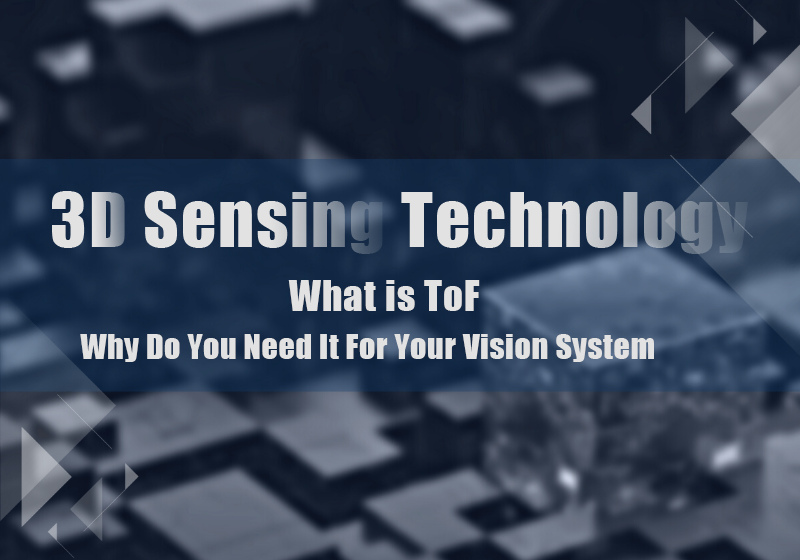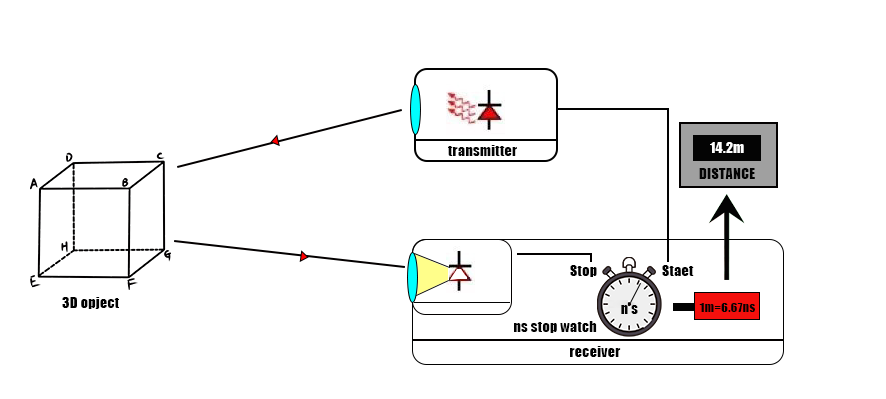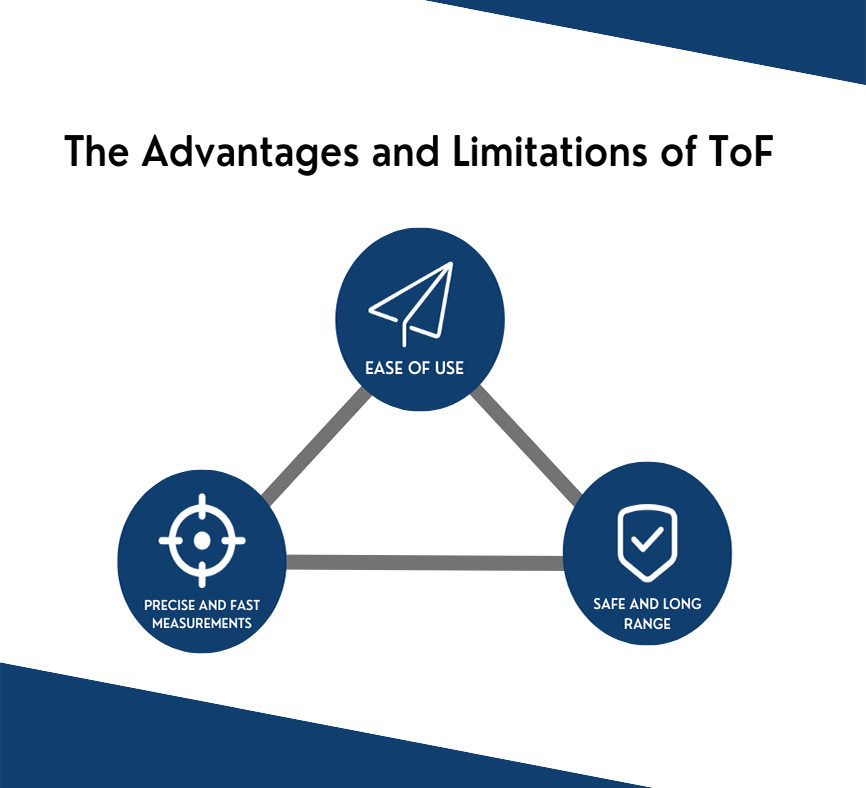

Analyzing 2D images is common in most machine vision applications, however, when it comes to scenarios that require measurements of both the surface and the height of an object, creating a 3D image of an object is necessary. Today, 3D imaging technology is widely used in many industries, such as robotics, logistics, or autonomous vehicles, and ToF technology is one of them.
What is ToF technology?
Time of Flight (ToF) indicates the measurement of the time taken by an object/particle/wave to travel a distance through a medium. By employing ToF techniques in a range imaging camera system, a ToF camera is able to capture both the depth and intensity information for every pixel in the image at the same time.
A ToF camera utilizes ToF measurement to determine distances between the camera and objects or environments, and create images generated by individually-measured points. Rather than the single point of a laser focus aid, each pixel of the ToF camera sensor offers a depth reading. A ToF camera calculates depth using the following formula: Distance = (speed of light x time-of-flight) / 2.
This depth information is independent of the intensity and object color, allowing us to separate the object from the background with simple algorithms. ToF cameras thus have great potential to improve the accuracy and efficiency of the machine vision system.

How Does A ToF Camera Work?
A ToF camera consists of the following main components: optics, integrated light source, image sensor, and interface.
Optics: Optical lens is used to gather the reflected light and image it on the optical sensor.
Image Sensor: As the key component of a ToF camera, it is used to receive the reflected light and perform photoelectric conversion on the sensor. Each pixel measures the time the light has taken to travel from the illumination unit to the object and back.
Illumination unit: The light-emitting unit is usually a VSCEL that can emit infrared light of a specific wavelength so as to make the illumination unobtrusive. VSCEL can transmit high signals with relatively low power.
Interface: The distance is calculated directly in the camera. The camera always provides a distance image over a USB or Ethernet interface to obtain good performance with calibration data.

A ToF camera works by first illuminating the scene with a pulsed or continuous wave light source. Then, we can observe the reflected light and determine how long the light took to bounce back from an object. The differences in return times and wavelengths are used to make precise digital 3D representations and surface characteristics of the target.
The ToF camera will capture a normal 2D-intensity image in parallel with the depth information. After merging the information sets, its individual features can be visually mapped out with a three-dimensional model imaging.
The Advantages and Limitations of ToF

Ease of Use:
Compare to stereo vision or triangulation systems, the ToF system has a relatively compact construction: the illumination is placed just next to the lens without the need for a certain minimum baseline or mechanical moving parts. The small size and light weight also make ToF sensors to be highly beneficial for certain scenarios such as smart buildings and level monitoring.
Precise and Fast Measurements:
ToF sensor is able to compose a 3D image quickly in contrast to other distance sensors such as ultrasonic or laser. In contrast to other distance sensors such as ultrasound or laser, ToF sensors are capable to work in both outdoor and indoor environments as it is unaffected by humidity, air pressure, and temperature. Moreover, the ToF camera can work in low light or even no light situations and creates high-resolution images with only medium costs.
Safe and Long Range:
Compared with other depth cameras, the illumination provided by the ToF camera emitting laser (VSCEL) transmitter is completely safe for the naked eyes. Meanwhile, the ToF sensor has the long-distance measurement with extremely high accuracy, which allows it to flexibly detect near and far objects of various shapes and sizes.
As great as a ToF camera is, it does have its limitations. First, the ToF distance measurement requires light that has been reflected just once. If the light is reflected multiple times, it might distort measurement and cause incorrect decisions. Second, although a ToF is capable of both indoor and outdoor use, ambient light (e.g. Sunlight) which has high intensity may still cause a quick saturation of the sensor pixels. Hence, the actual reflected light from the light source may not be detected accurately.
Conclusion
Even then, despite these limitations, there's still no quicker way to capture 3D information. ToF offers reliable solutions for a wide range of application scenarios. For example, in the logistics industry, ToF cameras offer great assistance for packaging, box filling, stacking, volume scanning, or labeling. In robotics and factory automation, we can easily detect damaged objects or stacking failures through ToF cameras. In the near future, it can also be perceived that the importance of ToF cameras in the field of medicine and automatic machines will also surge, as they serve as a valuable tool for automatic monitoring and safety warnings.
All these applications indicate that ToF technology is revolutionizing the machine vision industry by providing 3D information. SmartMoreInside offers a series of smart manufacturing solutions targeting different industrial needs, including a wide range of industrial cameras and 3D cameras. If you have any requirements, feel free to explore our storefront, we are here to offer the best products and best technical support for you!
Email format error
Email cannot be empty
Email already exists
6-20 characters(letters plus numbers only)
The password is inconsistent
Email format error
Email cannot be empty
Email does not exist
6-20 characters(letters plus numbers only)
The password is inconsistent